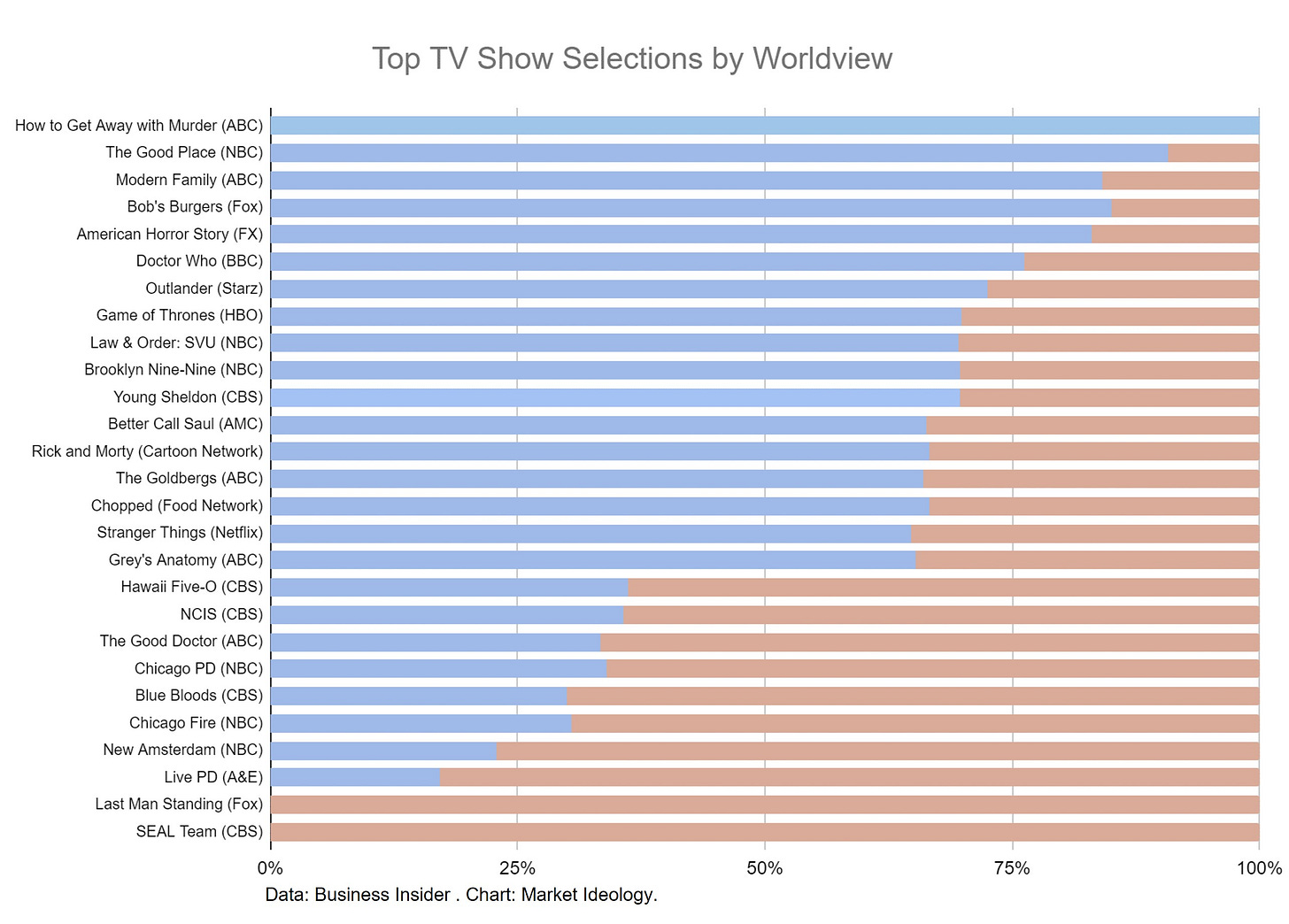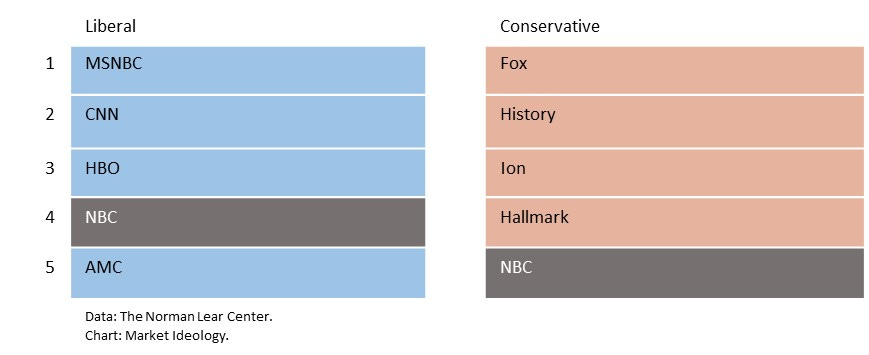Red and Blue TV: Two Mediaspheres, Seven Takeaways
Liberals and conservatives live in parallel universes, creating parallel markets, including the TV shows they watch. Their choices reflect how they see the world, and the entertainment taps into each group’s desires, fears, and dreams. By understanding these differences, you can better align your business with how your market thinks, whether it leans liberal or conservative. You can optimize your business to these markets with products and communications that reflect how your markets see the world and thinks.
This article draws upon two data sets, one from Business Insider (chart above) and one from The Norman Lear Center. Both have studied the TV consumption habits of liberals and conservatives. What’s missing in their work is the connection of viewership differences to how these two different social groups think. Sure conservative viewers prefer more police shows, but why? What is the relationship between this type of show and the conservative worldview?
The Business Insider data represents what conservatives and liberals report as favorite shows choosing a top five out of fifty from 2018. So it’s not a complete list, but it demonstrates the striking differences. We’ve translated the choices into ratios to make it easier to see how each group weights the different shows. A show with no blue or red indicates it did not make it into the top five for one group.
The data from The Norman Lear Center largely corroborates the Business Insider data and adds a few more interesting pieces of data. The Lear data also comes from surveys asking respondents to select favorite shows and networks. Here’s an example of how liberals and conservatives sort TV at the network level.
Here are seven takeaways from the data.
1. It’s not just news - it’s entertainment too
The worldview divide along conservative and liberal lines for news has been evident for decades, and the network chart above reflects it. What’s not so obvious is that conservatives and liberals consume distinctly different entertainment. TV entertainment reflects popular culture; in many cases, there are two cultures at work.
There’s nothing wrong with conservatives and liberals tuning into different entertainment - unless your business buys television media and it’s not aligned with your market, leading us to takeaway #2.
2. TV advertisers can optimize media investment by worldview to improve performance
Not everyone uses TV advertising to grow their business, but those that do now have a very low-cost way of improving results. Very few businesses consider worldview when evaluating markets because it feels like politics. Instead, most focus on gender, generations, life stage, income, measured behavior, and other attributes. Those are all important, but sitting on top of it all are two ways of seeing the world and two markets that perceive businesses, products, and communications very differently.
Optimizing television media investment to customer worldview is straightforward. You first measure the worldview makeup of your customers using database tools or urbanicity - the propensity of customers to live in urban vs. exurban or rural areas. You then compare it to the market to see if the two track together. Finally, you determine which of the two markets is more efficient for you and leverage insights into how a group thinks.
Certainly, you can decide to approach both worldview markets equally, but the odds are that your market skews in one direction. The worst situation is when you unwittingly align with the wrong worldview, creating inefficiencies leading to higher customer acquisition costs and lower customer value. Unfortunately, it frequently happens because it’s rare that brands evaluate customer worldview.
3. Two police shows demonstrate the different empathies of liberal and conservative customers (Law and Order: SVU, NCIS)
Law and Order: SVU focuses on victims with vulnerabilities - children, the elderly, disabled. The show explores complex issues around mental health, gender identity, sexual preference, and equality - in both the victims and main characters. The show is far more popular with liberals.
NCIS weaves the military into a police procedural series, following a fictional team of people from the Naval Criminal Investigative Service Major Case Response Team. The NCIS team focuses on crime scene investigation and murders of Navy and Marine Corps personnel. The show is far more popular with conservatives.
Each show asks the audience to empathize with very different people and situations, creating a split between worldview audiences. Adam Waytz, Professor of Management and Organizations at Kellogg School of Management, says that conservatives and liberals are both empathetic, but for different things and people. Conservatives are mostly empathetic to family and country. Liberals broaden their scope of empathy to friends and those who are socially disadvantaged. That distinction in empathy maps exactly to the relative successes of these two shows with liberals or conservatives.
Understanding this one cognitive concept - empathy - is at the core of how you can better understand your markets and align your business better. How your business projects empathy and communicates empathy can easily skew your customer acquisition, which may or may not align with your broader market.
4. Like the news, late-night talk shows go all in on half the country
The Lear Center research discusses shifts in audience by worldview with late-night talk shows. It’s a lesson in how intentional worldview market decisions can yield more profitable results or limit growth.
It is no surprise that liberals watch late-night talk shows more than conservatives because the hosts are generally liberal. What’s interesting is how the late-night talk show numbers act in lockstep with the growing separation of the two audiences in cable news. In both cases - news and late-night talk shows - there are clear business decisions to go all-in on one worldview.
When Jimmy Fallon replaced Jay Leno on The Tonight Show, the viewing audience shifted from conservative to liberal. Fallon tried to walk the worldview divide, but according to the Lear survey data, the audience shifted liberal. When Trevor Noah replaced Jon Stewart, there was no shift in audience as they are both very liberal. The overall migration toward a liberal worldview is very similar to that of CNN and MSNBC after 2000.
The void in late-night talk product for conservatives became apparent, so Fox filled it with Gutfeld! in 2015. In August 2021, Gutfeld! overtook The Late Show with Stephen Colbert in nightly ratings to become the highest-rated late-night talk show with an average of 2.12 million nightly viewers. As with the news, liberal products are spread more thinly across the liberal market. Gutfeld! has the business advantage of being the lone product for the other half of the country.
Suppose talk shows targeting liberal customers want to grow despite declining TV viewership. In that case, they must take viewers away from each other or broaden their worldview to include moderate conservatives. It’s hard to imagine the latter, but that’s exactly what CNN is undertaking right now under the new management of Chris Licht. News consumption is plummeting across the board, so news - and late-night talk shows - may be forced to broaden their audience, which, as a collateral benefit, would help reduce divisiveness.
5. Police and military shows reveal a preference for positional social attributes among conservative customers
The data clearly shows a conservative interest in police and military shows. It doesn’t seem surprising on the face of it, but what explains this?
The United States has a strong undercurrent of individualism across the entire population, liberal and conservative. It’s what drives the American Dream. Success is not predetermined by birth or other reason - at least, that’s the idea or promise.
Conservatives and liberals each add a different lens through which individualism is seen or interpreted. Those two lenses drive distinct differences in how each group sees the world and how they perceive entertainment and your business, products, and communications.
Mary Douglas, one of the most famous cultural anthropologists, developed a simple model for understanding social groups called Grid-Group, which can be applied here to understand American liberals and conservatives. She outlines four groups: individualist, fatalist, positional/hierarchical, and enclavist/egalitarian. What’s unique about American conservatives and liberals is that they combine attributes of two groups, both with a foundation in individualism. Future issues of this newsletter will explore this in more detail, but here’s a simple way to apply it here to conservatives and military shows:
For conservatives, the individualist social group is layered with attributes from the hierarchical/positional group. This group supports the presence of defined, rigid layers of authority. Individualism has a through-line to the hierarchical/positional social group - when an individual succeeds in a meritocratic, individualist social group, there tends to be a desire to maintain success through a hierarchical structure. In other words, achieving the American Dream can breed a desire to maintain a successful position through hierarchy for conservatives. This desire varies based on how conservative a customer is.
All to say that police and military shows lend themselves to positional or hierarchical preferences among American conservatives. There’s nothing wrong with it - it’s just an attribute of American conservatism. It won’t explain every individual, but it reveals itself as a theme with larger groups, your markets. Knowing this helps businesses consider their alignment with conservative or liberal markets to increase efficiency and market share.
6. Fantasy and supernatural shows reveal a preference for “magical danger” among liberal customers (American Horror Story, Outlander, Doctor Who, Game of Thrones)
While American conservatives view individualism through a hierarchical or positional lens, American liberals view individualism through an enclavist/egalitarian lens (see takeaway #5). This lens moderates the idea that everyone has an equal chance to succeed by working to correct perceived inequalities. The level of effort to correct inequalities varies based on how liberal a customer is.
A core attribute of the enclavist/egalitarian social group is resistance to any kind of hierarchical structure and a desire for an organization that is flat in terms of power or authority. Without clear leadership, this group has the potential to maintain coherence by viewing forces outside the group as something threatening or evil, thereby tightening the bonds within the group membership. There can be a sense that you are either “in” or “out” with this social group. What is “out” can be perceived as dangerous, evil, and even supernatural.
As Mary Douglas says about this group in Natural Symbols, “Magical danger is associated with the idea of boundary.” All to say that a more liberal worldview lends itself to association with horror, the supernatural, and witches. That’s a significantly simplified explanation that deserves elaboration in future issues, and I know it can sound a little far-fetched.
Even if you put that explanation aside, consider some research: Pew Research conducted a study on “new age” religious beliefs. In almost every case, those with a liberal worldview had significantly higher belief rates than conservatives. This includes reincarnation (33% vs. 18%), yoga (39% vs. 15%), spiritual energy (35% vs. 18%), and astrology (31% vs. 14%). No matter how you look at it, customers with a liberal worldview have an affinity with more supernatural beliefs.
It’s probably pure coincidence, but it’s hard not to think of former President Trump consistently accusing the Democrats of “witch hunts.”
7. It’s not just TV - it’s everywhere your customers engage
The TV data reveals interesting differences between conservative and liberal customers because it’s a visible part of popular culture. Yet it represents a small part of how each group engages with the world. What someone watches on TV is just one expression of a worldview, defined along conservative and liberal lines. Certainly, worldview is expressed in politics, but it’s also expressed in many other decisions customers make - the brands they prefer, the products they buy, where they choose to live, and even professions.
By understanding the differences in these two groups, you can align your business to your markets in a far more powerful way - and it will cost you little or nothing to do so.





